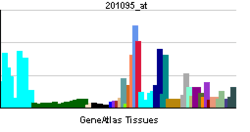DAP (gene)
| DAP | ||||||
|---|---|---|---|---|---|---|
| Identifiers | ||||||
| Aliases | DAP | |||||
| External IDs | MGI: 1918190 HomoloGene: 3235 GeneCards: DAP | |||||
| Genetically Related Diseases | ||||||
| inflammatory bowel disease, ulcerative colitis[1] | ||||||
| RNA expression pattern | ||||||
 | ||||||
| More reference expression data | ||||||
| Orthologs | ||||||
| Species | Human | Mouse | ||||
| Entrez | ||||||
| Ensembl | ||||||
| UniProt | ||||||
| RefSeq (mRNA) | ||||||
| RefSeq (protein) | ||||||
| Location (UCSC) | Chr 5: 10.68 – 10.76 Mb | Chr 15: 31.22 – 31.27 Mb | ||||
| PubMed search | [2] | [3] | ||||
| Wikidata | ||||||
| View/Edit Human | View/Edit Mouse |
Death-associated protein 1 is a protein that in humans is encoded by the DAP gene.[4][5][6]
DAP gene encodes a basic, proline-rich, 15-kD protein. Death-associated protein acts as a positive mediator of programmed cell death that is induced by interferon-gamma.[6]
References
- ↑ "Diseases that are genetically associated with DAP view/edit references on wikidata".
- ↑ "Human PubMed Reference:".
- ↑ "Mouse PubMed Reference:".
- ↑ Feinstein E, Druck T, Kastury K, Berissi H, Goodart SA, Overhauser J, Kimchi A, Huebner K (Feb 1996). "Assignment of DAP1 and DAPK--genes that positively mediate programmed cell death triggered by IFN-gamma--to chromosome regions 5p12.2 and 9q34.1, respectively". Genomics. 29 (1): 305–7. doi:10.1006/geno.1995.1255. PMID 8530096.
- ↑ Deiss LP, Feinstein E, Berissi H, Cohen O, Kimchi A (Feb 1995). "Identification of a novel serine/threonine kinase and a novel 15-kD protein as potential mediators of the gamma interferon-induced cell death". Genes Dev. 9 (1): 15–30. doi:10.1101/gad.9.1.15. PMID 7828849.
- 1 2 "Entrez Gene: DAP death-associated protein".
Further reading
- Levy-Strumpf N, Kimchi A (1999). "Death associated proteins (DAPs): from gene identification to the analysis of their apoptotic and tumor suppressive functions". Oncogene. 17 (25): 3331–40. doi:10.1038/sj.onc.1202588. PMID 9916995.
- Olsen JV, Blagoev B, Gnad F, et al. (2006). "Global, in vivo, and site-specific phosphorylation dynamics in signaling networks". Cell. 127 (3): 635–48. doi:10.1016/j.cell.2006.09.026. PMID 17081983.
- Zougman A, Wiśniewski JR (2006). "Beyond linker histones and high mobility group proteins: global profiling of perchloric acid soluble proteins". J. Proteome Res. 5 (4): 925–34. doi:10.1021/pr050415p. PMID 16602700.
- Gerhard DS, Wagner L, Feingold EA, et al. (2004). "The Status, Quality, and Expansion of the NIH Full-Length cDNA Project: The Mammalian Gene Collection (MGC)". Genome Res. 14 (10B): 2121–7. doi:10.1101/gr.2596504. PMC 528928
 . PMID 15489334.
. PMID 15489334. - Suzuki Y, Yamashita R, Shirota M, et al. (2004). "Sequence Comparison of Human and Mouse Genes Reveals a Homologous Block Structure in the Promoter Regions". Genome Res. 14 (9): 1711–8. doi:10.1101/gr.2435604. PMC 515316
 . PMID 15342556.
. PMID 15342556. - Strausberg RL, Feingold EA, Grouse LH, et al. (2003). "Generation and initial analysis of more than 15,000 full-length human and mouse cDNA sequences". Proc. Natl. Acad. Sci. U.S.A. 99 (26): 16899–903. doi:10.1073/pnas.242603899. PMC 139241
 . PMID 12477932.
. PMID 12477932.
This article is issued from Wikipedia - version of the 6/8/2016. The text is available under the Creative Commons Attribution/Share Alike but additional terms may apply for the media files.